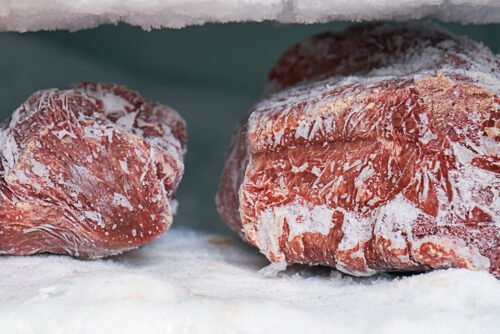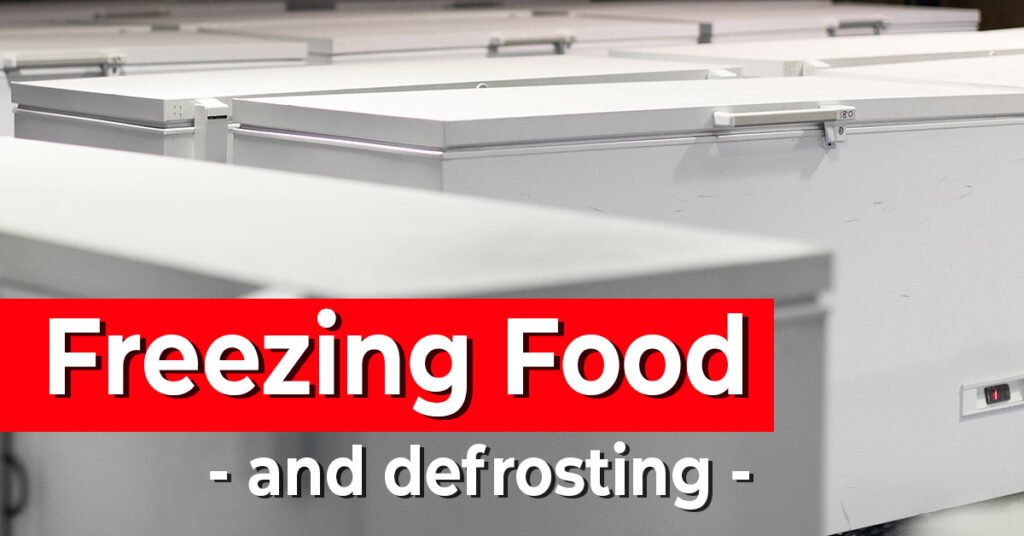Freezing and defrosting food effectively can be a game changer in your kitchen. This is the second of a two-part article about freezing foods and looks at the many ways to freeze food (including specifics for common food types), as well as a few suggestions for getting the most out of your freezer itself. It can be a wonderful piece of equipment.
In Part I we looked at the basics of freezing food, and how to freeze vegetables, fruit and meat. This week we’ll talk about the ways to save money by using a chest freezer, and the all-important defrosting of foods.
Understanding Freezing Basics
- Optimal Freezing Practices: Maintain your freezer at or below 0°F to effectively freeze food. Use appropriate packaging like freezer bags, airtight containers, and heavy-duty foil to protect against freezer burn and preserve food quality.
- Ideal Foods for Freezing: Certain foods like fruits, vegetables, raw and cooked meats, butter, and cookies freeze well. However, some items like lettuce, mayonnaise, and cream may lose quality when frozen.
- Safe Defrosting Techniques: Thaw food in the refrigerator for a safe and gradual process, use cold water for a faster method, or microwave for the quickest thawing. Some foods like most vegetables and bread can be cooked directly from their frozen state.
- Proper Storage and Labeling: Avoid refreezing partially defrosted food to maintain quality. Label and date frozen items for efficient management and to follow the ‘first in, first out’ rule
Why Freeze?
- Preserves Quality: Freezing keeps food safe by halting the growth of bacteria, yeasts, and molds.
- Extends Shelf Life: Ideal for perishable items like meat, poultry, and vegetables.
Using a chest freezer

A chest freezer is little more than a ‘standard’ vertical freezer lying down. Think of the ones in smaller stores which are filled with ice cream sandwiches’ or popsicles. Popular, but not so good for us.
Unfortunately, these aren’t quite as popular as their upright cousins, and are often found in the dim, dark corners of department stores and electrical good suppliers. Pity, really – because they’re superb when you know how to use them.
There are two things which put the chest freezer at the top of the list when it comes to keeping food frozen for a while. These are :
Storage : whilst upright freezers often have shelves, ice-cube trays and automatic defrosting gear; chest freezers are generally little more than a big open box. Perfect for large slabs of meat and trays of vegetables. The big stuff.
Stay cold : when the door is opened on vertical freezers, the cold air tends to come out and down (chilling your feet if you stand there long enough); as warmer air rushes in to take its place.
With a chest freezer, the cold air is already sitting near ground level – so there’s less chance of it going anywhere.
In short, chest freezers tend to keep the cold air on the inside, where it belongs. They’ll be cheaper to run.
Chest freezers will save you money
OK, the good part – saving money. There are three ways that the humble chest freezer will help out in this department :
Cheaper to buy : as they’re less common, they’re usually cheaper to buy. If cash is really tight, grab a second-hand one from a repairer, the classified ads or online auction sites like eBay. They last for years.
Cheaper to run : chances are you won’t be lifting the lid quite as often (there’s less temptation to just stand there thinking ‘now, what do I want‘ with a chest freezer – they’re practical things), and the freezer won’t lose as much of the cold each time. Lower electricity bills.
Cheaper to fill : the wide, open space of a chest freezer actually encourages you to buy larger items (which are often cheaper, incidentally) and store them for a long time *. Rather than single-serve tubs of ice-cream, you’ll be filling it those enormous fish you caught over the weekend.
* to find out what you can freeze, and how long it will last, check out Part I of this article.
Best Practices for Freezing
- Temperature Control: Keep your freezer at or below 0°F.
- Proper Packaging: Use freezer bags, airtight containers, and heavy-duty foil for optimal protection against freezer burn.
What to Freeze
- Ideal Foods: Fruits, blanched vegetables, raw and cooked meat, butter, and cookies are great for freezing.
- Special Considerations: Glass jars can be used for freezing, but need careful handling.
Final thoughts on Chest Freezers
Whether you’re buying seafood, fruits and vegetables, game or just a few steaks for the coming weeks – a chest freezer is a great investment. And finally, you’ll have somewhere to put that pasture raised half cow you bought for your family.
The Art of Defrosting
The whole point of freezing, of course, is to keep food until you’re ready to use it. Before it reaches the oven/pan/grill, however, there’s one crucial step – defrosting.
Defrosting simply puts the food back in the state (or as close to it as possible) it was in before you put it in the freezer. It’s ready to cook, if you like.
Why Thaw?
- Restore State: Defrosting brings food back to its pre-frozen state, making it ready to cook.
Foods that don’t require defrosting
Before we look at the many ways to defrost foods, here are a couple of quick exceptions. These foods can be cooked directly from their frozen state, or even eaten as-is.
- Direct Cooking: Some items like most vegetables and bread can be cooked directly from frozen
Most vegetables : the vast majority of vegetables can simply be thrown into a pot of boiling water (or popped into the microwave) in their frozen state. Notable exceptions are mushrooms, which like to be given a bit of time to thaw out. Just leave them in the fridge for a couple of hours before using them.
Bread : somewhat surprisingly, bread can be cooked directly from frozen. For things like baguettes, just wrap them in foil and pop them in the oven; for toast, well, just put the frozen slices straight into the toaster.
Various ways to defrost foods
On a tray, in the fridge : this is the preferred method of defrosting most items – particularly meat and fish. Place the frozen item on a tray or plate (to catch the juices) and put it in the bottom of the fridge. Just in case.
Time : this will take up to 6 hours for smaller pieces of meat and fish; and up to 1-2 days for larger joints (about 24 hrs / lb). Whole animals (say, frozen turkeys) are a little quicker – around 24 hrs / 5 lb.
NB : I realise that this is an extremely long time to wait, but it’s worth the effort. If you cook partially frozen meat, it’ll be cooked on the outside while the inside is still raw.
In a large bowl of water : if a day or two sounds prohibitive, an alternative method is to place the frozen item in a plastic bag, and completely submerge in a large bowl of water (if necessary, just weigh it down with a plate and the nearest heavy object). To make sure the water stays fairly cold, change it every 30 minutes or so.
Time : about 30 mins / lb .
NB : A common way to defrost items like prawns is to sit them under a running tap for a while. Not only does this waste an incredible amount of water; the prawns lose quite a bit of their flavour. Just let them sit in the fridge for a time.
In the microwave : if you’re really pressed for time, look no further than the microwave (most of them now have dedicated settings for defrosting, based on the weight of the food).
Time : this varies quite a bit from machine to machine, and also with the size and type of food. For most things though, you’re looking at half an hour or less.
Safe Thawing Methods
- Refrigerator Thawing: Safe and gradual, taking up to 1 day per pound.
- Cold Water Thawing: Faster, involving submerging in cold water with regular water changes.
- Microwave Thawing: Quick but requires immediate cooking post-thaw.
FDA Approved Way To Defrost Meat Quickly & Safely
When you need to quickly thaw small cuts of meat, use this kitchen hack. Heat water to 140°F, hotter than your tap. Place frozen meat in a bag and submerge it. Thaw chicken in about 10 minutes, other cuts in 12. Don’t exceed 45 minutes. Not suitable for big roasts or birds.
To quickly thaw small cuts of meat, use hot water and food storage bags as shown in the video.
- Heat water to 140°F, slightly hotter than home taps.
- Place frozen meat in a storage bag and submerge in hot water.
- Thawing time is about 10 minutes for chicken and 12 minutes for other cuts.
- Don’t leave meat in hot water for longer than 45 minutes.
- This method is not suitable for larger roasts or whole birds.
Final Tips and Tricks
In general, allow foods to thaw out as slowly as possible. This will allow them return to their pre-frozen state – or as close to it as you can get.
Once foods have partially defrosted, avoid the temptation to put them back in the freezer. A bag of frozen peas will easily survive the trip home from the supermarket; but a steak that’s been thawing in the fridge for 6 hours won’t be happy if you suddenly decide you want fish instead.
Do’s and Don’ts
- Avoid Refreezing: Partially defrosted food shouldn’t be refrozen to maintain quality.
- Be Organized: Label and date your frozen items for better inventory management
In essence, effectively freezing and defrosting food hinges on maintaining the right freezer temperature (at or below 0°F), using proper packaging to prevent freezer burn, and understanding which foods freeze well.
Meats, fruits, and certain vegetables are ideal for freezing, while foods like lettuce and mayonnaise may not fare as well. Safe defrosting can be done in the refrigerator, in cold water, or using a microwave, with some foods like bread and most vegetables being cookable straight from frozen.
Properly labeling and dating frozen items is crucial for efficient management and avoiding food waste.
This was part two of our Ultimate Guide to Freezing Food and we hope you got some value out of it.
